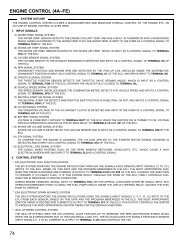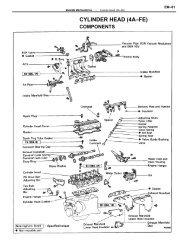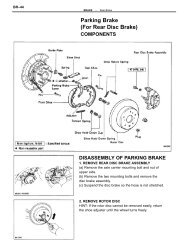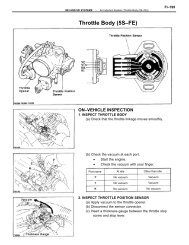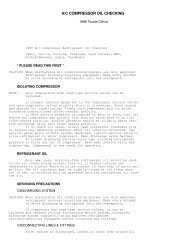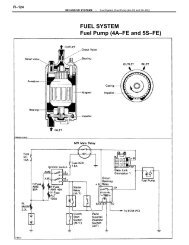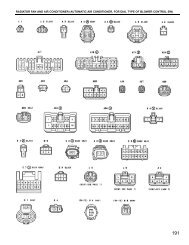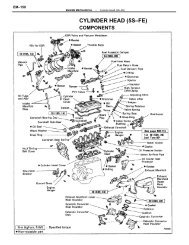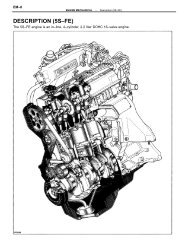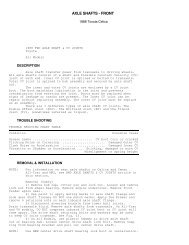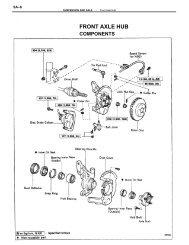turbocharger - CelicaTech
turbocharger - CelicaTech
turbocharger - CelicaTech
You also want an ePaper? Increase the reach of your titles
YUMPU automatically turns print PDFs into web optimized ePapers that Google loves.
TURBOCHARGER<br />
1988 Toyota Celica<br />
1988 TURBOCHARGING SYSTEMS<br />
All Models<br />
DESCRIPTION<br />
Most models use a water-cooled <strong>turbocharger</strong>, mounted<br />
directly to the exhaust manifold with a wastegate assembly attached<br />
to rear of turbine housing. The <strong>turbocharger</strong> consists of a<br />
turbine/compressor assembly, oil supply system and wastegate. Other<br />
components include impellers, impeller shaft, bearings and impeller<br />
housings.<br />
The safety valve of the system is a pressure actuated<br />
wastegate that prevents excessive intake boost pressure.<br />
Turbocharger operation requires a large quantity of clean<br />
oil to prevent bearing failure. Engine oil pressure provides constant<br />
lubrication to the system.<br />
Fig. 1: Typical Turbocharger<br />
OPERATION<br />
At idle and light throttle, the Turbo engine operates like a
standard engine. When more power is required, exhaust gases from<br />
exhaust manifold enter the <strong>turbocharger</strong>’s turbine housing and flow<br />
through the turbine blades.<br />
Exhaust flow and turbine speed increase as throttle opens<br />
and RPM increases. The impeller turns with turbine and forces air<br />
into compressor housing and intake manifold. As impeller and turbine<br />
speed increases, boost pressure also increases.<br />
If boost pressure exceeds safe limits, engine damage may<br />
result. The wastegate opens when exhaust pressure exceeds a<br />
predetermined limit and allows exhaust gases to by-pass compressor.<br />
OPERATING PRECAUTIONS<br />
When Starting<br />
After engine has started, allow it to run at idle for several<br />
minutes. If engine has been shut down for a long period, be sure to<br />
run engine at idle until engine oil has circulated throughout engine.<br />
When <strong>turbocharger</strong> is replaced, remove oil pipe by loosening top flare<br />
nut and pour fresh engine oil directly into oil filler port.<br />
During Operation<br />
Monitor oil pressure gauge to confirm that constant oil<br />
pressure is available. If abnormal noise is produced by rotating parts<br />
of <strong>turbocharger</strong>, or unusual vibration is noted, stop operation and<br />
check.<br />
When Stopping<br />
Allow engine to run at idle for several minutes before<br />
stopping engine. If engine is operated at high load, then stopped<br />
abruptly, the engine oil supply is cut off while the <strong>turbocharger</strong> is<br />
still very hot. The <strong>turbocharger</strong> bearings will be overheated and could<br />
be damaged.<br />
TROUBLE SHOOTING<br />
NOTE:<br />
Check the following items. If found defective, replace<br />
<strong>turbocharger</strong> assembly. If related parts are defective,<br />
repair or replace.<br />
VIBRATION OR NOISE<br />
1) Inspect for defective bearings or interference of<br />
rotating parts with related objects. Consider neglect of engine oil<br />
change, sustained use with contamination in oil pipe, a restricted or<br />
broken oil filter. Check for repeated abrupt starts and stops that<br />
could cause bearing failure.<br />
2) If nothing is wrong with lubricating system, an<br />
incorrectly balanced rotating section or bent shaft may be suspected.<br />
This is due to excessive wear of bearings or contamination that have<br />
caused damage to turbine or compressor wheels.<br />
3) If any of these conditions exist, <strong>turbocharger</strong> assembly<br />
must be replaced. Before a new <strong>turbocharger</strong> assembly is installed,<br />
carefully check for contamination or pieces of broken turbine or<br />
compressor wheels which might be left in manifold system.<br />
LOW BOOST PRESSURE<br />
1) Check air cleaner element for contamination or clogging<br />
and clean or replace element as necessary. If turbine or compressor<br />
wheels do not rotate smoothly and lightly when turned by hand,<br />
replace <strong>turbocharger</strong> assembly. Check wastegate valve or relief valve<br />
which might be left opened.
2) If <strong>turbocharger</strong> appears to be good, but has low boost<br />
pressure, check for the following:<br />
* Gas leaks in exhaust system.<br />
* Deformed or clogged exhaust pipe or muffler which might be<br />
causing increased exhaust resistance.<br />
* Air leaks from compressor discharge side.<br />
WHITE EXHAUST SMOKE<br />
Sustained engine operation with faulty bearings will result<br />
in failure of oil seal which could cause leakage of engine oil into<br />
exhaust and intake pipes. Leakage of engine oil from <strong>turbocharger</strong><br />
into exhaust pipe or intake pipe will result in White colored<br />
exhaust. If this occurs, check for clogged, crushed or deformed oil<br />
return pipe. If nothing is wrong with oil return pipe, leakage is<br />
probably due to wear of piston ring (seal ring) in <strong>turbocharger</strong>.<br />
TESTING<br />
Pressure Check<br />
1) For Camry, connect a 3-way union to boost compensator<br />
pressure hose and install a pressure gauge to it. While driving with<br />
engine running at 2500 RPM or more (accelerator pedal fully depressed<br />
in first gear).<br />
2) For Pickup, connect a pressure gauge to fuel filter.<br />
While driving with engine running at 2400 RPM or more (accelerator<br />
pedal fully depressed in low range). Check the turbocharging<br />
pressure. Standard pressure is 7.7-9.7 psi (.54-.68 kg/cm ) for<br />
Camry and 5.8-7.7 psi (.41-.54 kg/cm ) for Pickup.<br />
3) If pressure is less than specification, first check<br />
intake air and exhaust systems and relief valve for leakage. If there<br />
is no leakage, replace <strong>turbocharger</strong> assembly. If pressure is above<br />
specification, first check if the actuator hose is disconnected or<br />
cracked. If not, replace <strong>turbocharger</strong> assembly.<br />
Intake Air System<br />
Check for leakage or clogging between the air cleaner and<br />
<strong>turbocharger</strong> inlet and between <strong>turbocharger</strong> outlet and cylinder head.<br />
If air cleaner is clogged, clean or replace element. Repair or replace<br />
any collapsed or deformed hoses. Check and repair any leaking<br />
connections. Check and replace cracked components.<br />
Exhaust System<br />
Check for leakage or clogging between the cylinder head and<br />
<strong>turbocharger</strong> inlet and between the <strong>turbocharger</strong> outlet and exhaust<br />
pipe. Repair or replace deformed components. Remove foreign material<br />
in passages. Repair or replace leaking and cracked components.<br />
Actuator & Wastegate<br />
Disconnect actuator hose. Using a pressure gauge, apply 8.2-<br />
8.7 psi (.58-.61 kg/cm ) of pressure to actuator hose and check that<br />
rod moves .0098" (.25 mm) or more. If less, replace <strong>turbocharger</strong><br />
assembly.<br />
CAUTION: Never apply more than 11.4 psi (.8 kg/cm ) of pressure to<br />
the actuator.<br />
Impeller Wheel Rotation<br />
Disconnect air cleaner hose. Grasp edge of impeller wheel and<br />
turn it. Verify that it turns smoothly. If it does not turn or if it<br />
turns with drag, replace <strong>turbocharger</strong> assembly.
Relief Valve<br />
Check outside of relief valve for excessive oil oozing. If no<br />
oil oozing is found, the relief valve is okay. If oil oozing is found,<br />
replace the relief valve and check the performance. If there is no<br />
change in performance, the relief valve is okay.<br />
Indicator Light & Warning Light Operation<br />
1) Verify that Green indicator light and Amber warning light<br />
illuminate when ignition is turned on. If not, check 7.5A "GAUGE",<br />
"CHG" and "IGN" fuses. If fuses are blown, check for short and repair<br />
as necessary. If the fuses are okay, check to see if discharge warning<br />
light is out. If it is okay, the charging system is faulty. If the<br />
light is out, the combination meter is faulty.<br />
2) If Green indicator and Amber warning lights illuminate<br />
when ignition is turned on, check to see if indicator and warning<br />
lights are out during engine idle. If both lights and discharge<br />
warning light are on, the charging system is faulty. If both lights<br />
stay on and discharge warning light is off, go to step 4).<br />
3) If Green light stays on, check for open circuit in wire<br />
harness between low pressure switch and combination meter. If circuit<br />
is okay, replace faulty low pressure switch. If Amber light comes on,<br />
check for open circuit in wire harness between high pressure switch<br />
and combination meter and check for ground connection of switch.<br />
Repair either circuit as necessary.<br />
4) If both indicator and warning lights are out during<br />
engine idle, check to see if Green indicator light comes on when 2<br />
psi (.14 kg/cm ) pressure is applied to both pressure switches. If<br />
Green indicator does not come on, check for short circuit in wiring<br />
harness between low pressure switch and combination meter. If circuit<br />
is okay, replace faulty low pressure switch.<br />
5) If Amber light comes on, see if Green indicator light<br />
comes on when 11.9 psi (.84 kg/cm ) pressure is applied to both<br />
switches. If not, replace faulty high pressure switch. If it does<br />
come on, combination meter is faulty.<br />
6) If the Green indicator light does come on when the<br />
pressure in step 4) is applied, check to see if Amber indicator light<br />
comes on when 11.9 psi (.84 kg/cm ) is applied to both switches.<br />
7) If not, check for short circuit in wire harness between<br />
high pressure switch and combination meter. If no short circuit is<br />
present, replace faulty high pressure switch. If Amber light does<br />
light when pressure is applied, <strong>turbocharger</strong> indicator and warning<br />
light operation are okay.<br />
REMOVAL & INSTALLATION<br />
Removal<br />
1) Disconnect negative battery cable. Drain coolant.<br />
Disconnect oxygen sensor wire and connector. Disconnect PCV hose from<br />
cylinder head cover. Loosen clamp and disconnect air cleaner hose from<br />
<strong>turbocharger</strong>.<br />
2) Remove 4 clips and remove air cleaner hose with air<br />
cleaner case cover. Disconnect <strong>turbocharger</strong> pressure hose to<br />
compressor elbow. Loosen clamp and disconnect air intake hose from<br />
intake manifold.<br />
3) Remove bolt holding elbow stay to engine. Remove 2 bolts<br />
and compressor elbow with relief valve and air intake hose. Remove<br />
compressor elbow gasket. Remove <strong>turbocharger</strong> heat insulators. Remove 3<br />
nuts from flange. Disconnect exhaust pipe from manifold and remove<br />
gasket.<br />
4) Remove <strong>turbocharger</strong> oil pipe flange nuts. Remove 4 nuts<br />
and remove <strong>turbocharger</strong>, <strong>turbocharger</strong> gasket and flange gasket from
exhaust manifold. Remove 4 nuts, washers, turbine elbow and gasket.<br />
Remove relief valve from compressor elbow.<br />
Inspection<br />
1) To inspect impeller wheel rotation, grasp edge of turbine<br />
wheel and turn it. Check that impeller wheel turns smoothly. If<br />
impeller wheel does not turn or if it turns with a drag, replace<br />
<strong>turbocharger</strong> assembly.<br />
2) To inspect axial play of shaft bearing, insert a dial<br />
gauge into intake side, hold turbine wheel edge by hand and check<br />
axial play. Standard clearance is .0051" (.13 mm). If not within<br />
specification, replace <strong>turbocharger</strong> assembly.<br />
Installation<br />
1) Install relief valve to compressor elbow and tighten nuts<br />
to 27 ft. lbs. (37 N.m). Install gasket and turbine elbow with 4 nuts<br />
and washers and tighten nuts to 18 ft. lbs. (25 N.m). Place a new<br />
gasket with protrusion on opposite side of cylinder head.<br />
NOTE:<br />
After replacing a <strong>turbocharger</strong> assembly, pour 20 cc of new<br />
oil through oil inlet while turning impeller wheel to splash<br />
oil on bearing.<br />
2) Install <strong>turbocharger</strong>, with a new oil pipe gasket, to<br />
exhaust manifold and oil pipe. Install nuts and tighten to 38 ft.<br />
lbs. (52 N.m). Install <strong>turbocharger</strong> oil pipe flange nuts and tighten<br />
to 13 ft. lbs. (18 N.m). Place a new gasket on exhaust pipe.<br />
3) Connect exhaust pipe and install flange nuts. Tighten to<br />
9 ft. lbs. (13 N.m). Install <strong>turbocharger</strong> heat insulators. Install<br />
compressor elbow with relief valve and air intake hose with 2 bolts<br />
and new gasket. Tighten bolts to 9 ft. lbs. (13 N.m).<br />
4) Connect elbow stay to engine. Connect air intake hose to<br />
intake manifold with clamp. Connect <strong>turbocharger</strong> pressure hose to<br />
compressor elbow. Install air cleaner case cover and air cleaner hose<br />
with 4 clips. Connect air cleaner hose to <strong>turbocharger</strong> with clamp.<br />
Connect PCV hose to cylinder head cover.



